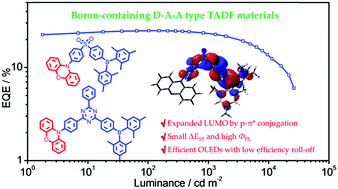Boron-containing D–A–A type TADF materials with tiny singlet–triplet energy splittings and high photoluminescence quantum yields for highly efficient OLEDs with low efficiency roll-offs†
Abstract
Thermally activated delayed fluorescence (TADF) emitters have great potential for use in commercial organic light-emitting diode (OLED) displays/lighting. One of the usually confronted issues of TADF emitters is that short triplet-exciton lifetimes and a high photoluminescence quantum yield (ΦPL) are hard to achieve simultaneously. In this study, by integrating a bismesitylboryl acceptor with a triazine/sulfonyl acceptor, tandem acceptors were assembled and utilized to construct two donor–acceptor–acceptor (D–A–A) types of TADF compounds. These compounds show a very small singlet–triplet energy splitting (ΔEST: < 0.04 eV), which results in fast deactivation of triplet excitons via reverse intersystem crossing (RISC) and, correspondingly, a fairly short delayed-fluorescence lifetime (τDF: <4 μs in doped films). Meanwhile, high ΦPL values of 65 and 84% were maintained by the compounds. The short ΔEST is contributed by the large HOMO–LUMO spatial separation caused by the expanded LUMO distribution that is due to the unique p–π* conjugation between boron and the other parts of the tandem acceptor. Benefiting from the small ΔEST and high ΦPL, OLED devices based on these emitters showed a maximum external quantum efficiency reaching 24.8% and a very low efficiency roll-off of 5.6% at a practical luminance of 1000 cd m−2. This study indicates that expanding the acceptor unit of the D–A type of TADF materials through introducing the empty p-orbital of boron is an effective strategy for the development of TADF materials towards high-performance OLEDs.



 Please wait while we load your content...
Please wait while we load your content...